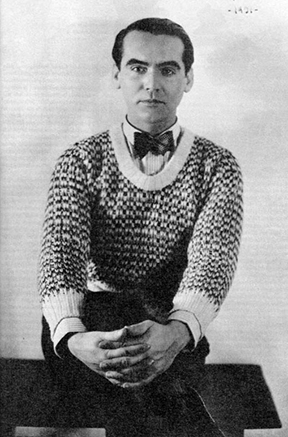Dramaturgical Resources
2015
Yerma
By Federico Garcia Lorca
Over the course of the season, our assistant directors and student dramaturgs will be compiling dramaturgical resources relating to each production as it develops. Below are some links to websites which relate to the history of the play, the biography of the playwright, and sites that contextualize and, we hope, shed light on the directorial approach to the dramatic material.
We hope you find these resources of interest.

Federico Garcia Lorca (June 5, 1898 – August 20?, 1936)
“Theatre is poetry that rises from the book and becomes human enough to talk and shout, weep and despair.”
The Playwright
“The artist, and particularly the poet, is always an anarchist in the best sense of the word. He must heed only the call that arises within him from three strong voices: the voice of death, with all its foreboding, the voice of love and the voice of art.”
Federico García Lorca is considered one of Spain's greatest poets and dramatists. His plays and poetry have been critically acclaimed worldwide, and translated into more than thirty different languages.
Lorca was born in June 5, 1898, in Fuente Vaqueros, a small town in the province of Granada, Spain. His father, Federico García, was a prosperous landowner, and his mother, Vicenta Lorca, a primary school teacher. He was the eldest of three children.
In 1915, Federico started attending the University of Granada to study law. However, he was more interested in spending his time reading literature, playing piano and writing music. His affinity for the latter led to a friendship with composer Manuel de Falla, with whom he organized a festival to promote flamenco performance in the city of Granada.
In 1919, Lorca moved to Madrid to live at the Residencia de Estudiantes, a progressive, Oxbridge-inspired residence for students. At the residencia, Lorca befriended filmmaker Luis Buñuel and surrealist painter Salvador Dalí. He later started a passionate affair with Dalí that led him to acknowledge, if not entirely accept, his own homosexuality, a stigma that he often expressed through his work.
A year later, Lorca presented his first play, The Butterfly's Evil Spell, a symbolist piece inspired by the poetry of W.B. Yeats and Maeterlinck. The production, which included actors wearing insect costumes, was considered a complete failure.
Consequently, his next play, Mariana Pineda, did not open until 1929. The sets and costumes were designed by Dalí and it was performed by the company of Margarita Xirgu, one of the great dames of the Spanish theatre. It was a huge success.
That same year, Lorca travelled to New York City to attend Columbia University, where he wrote Poet in New York, a collection of poems about his experiences living abroad in Manhattan and Cuba, and The Public, one of his most experimental theatrical pieces.
In 1931, upon his return to Spain, he funded La Barraca, a touring theatre company that performed Lorca's adaptations of Spanish Golden Age dramas. The productions that were put on, works by 16th Century playwrights like Lope de Vega or Calderon de la Barca, heavily influenced Lorca's later plays.
While touring, Federico wrote what is nowadays considered to be his true masterpiece: a rural trilogy that included Blood Wedding, The House of Bernarda Alba and Yerma, three plays concerned with life, death, love and desire in rural Spain. This cycle of tragedies became hugely popular, and eventually turned to be a referent for the Spanish literary cannon worldwide.
Lorca's life came to an end on August 19, 1936, just a month after the Spanish Civil War broke out. The war was a conflict in which he had found himself caught in the middle. Lorca was not officially affiliated with any political party, but as a homosexual artist, he was associated with what the Right defined as “degenerate art”. He was shot without trial by a group of supporters of General Francisco Franco.
Despite his short life, Lorca managed to write many other plays and much poetry. For an extensive list of his major works, click here.
About the Play
“To burn with desire and keep quiet about it is the greatest punishment we can bring on ourselves.”
Yerma opened on December 29, 1934, at the Teatro Español in Madrid. The Right attempted to disrupt the performance, but the play was received with an overwhelmingly positive response from both audience and critics.
Lorca drew inspiration from a real-life source: the story of Matilde Palacios, his father's first wife, who had failed to produce a child in fourteen years of marriage. The photographs and portraits of Palacios, who had died at age thirty-four from an intestinal obstruction, haunted Lorca's imagination, who was obsessed with the figure of this woman who could have been his own mother.
Another source of inspiration for the construction of the play was a production of Medeathat Lorca had seen a year before at the same theatre. The author borrowed many elements from Greek tragedy, echoing Euripides' piece in terms of story and structure.
Moreover, Lorca mixed dyonisiac traditions with pagan elements of Spanish folklore. Scholar Ian Gibson has also stated that Yerma is the play of Lorca’s that most openly challenges the institution of Catholicism and the strict sexual morality of Spanish society at the time.
